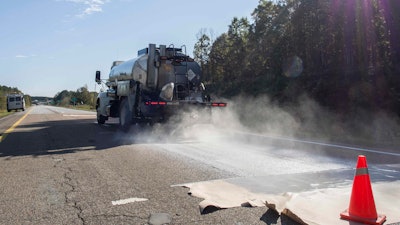
To extend the life of asphalt pavement that’s still performing well, spray-on rejuvenators, also known as rejuvenating seals, are sometimes used. These rejuvenators are designed to improve the flexibility of the pavement which can become stiff and brittle over time, leading to surface deterioration. The idea is that they preserve the functional and structural integrity by keeping the pavement softer and more pliable, making it less likely to crack under the force of traffic.
Rejuvenators are cost-effective pavement preservation treatments when applied to surfaces still in good condition. The treatments address the stiffening and brittleness of the asphalt binder in the 9 mm (3/8 inch) of the surface layer. Treatments restore the binder's properties, reducing cracking and prolonging the pavement's life. They can be reapplied every one to four years to extend the life of the pavement.
 A truck applies Delta Mist to the NCAT test track. The non-toxic rejuvenator requires no pre-heating or special equipment and is applied as a milky white substance which dries clear.Provided by Collaborative Aggregates
A truck applies Delta Mist to the NCAT test track. The non-toxic rejuvenator requires no pre-heating or special equipment and is applied as a milky white substance which dries clear.Provided by Collaborative Aggregates
Testing the Effectiveness of a Pavement Rejuvenation Treatment
As part of the National Center for Asphalt Technology (NCAT) 2018 Test Track research cycle, the Mississippi Department of Transportation sponsored a spray-on rejuvenator experiment. The study’s objective was to evaluate the field performance of the spray-on rejuvenator product Delta Mist compared to a controlled section of pavement. Both short- and long-term effectiveness in renewing asphalt surfaces were evaluated, as well as the effects on surface friction after application.
The study was recommended for traffic continuation in the 2021-2024 research cycle to further monitor and evaluate the applied product’s long-term performance. While products may work well in the short term, they age differently. An extended study reveals the product’s actual effectiveness.
What Is Delta Mist?
Delta Mist is a liquid, plant-based asphalt rejuvenator product that penetrates the surface and softens the asphalt binder to improve cohesion while retarding crack propagation of the pavement surface.
The milky white substance dries clear and doesn’t obscure traffic markings or affect reflectivity. In fact, the average value of the retroreflectivity measurements taken on the centerline of the section of the track tested was 279 mcd/m2/lx. According to the 2016 Supplemental Notice of Proposed Amendment (SNPA) to the 2009 Manual for Uniform Traffic Control Devices (MUTCD), retroreflectivity at or above 100 mcd/m2 /lx is deemed safe for roadways with statutory or posted speed limits of 70 mph or greater.
Delta Mist requires no pre-heating or heat to apply and needs no sand or aggregate cover.
Safe for workers and the environment, non-toxic Delta Mist releases no volatile organic compounds, or VOCs, into the air. While there are currently no specifications for emissions, NCAT says this will likely be studied in the future.
How the Test Was Conducted
During the 48-month study, weighted tractor-trailer flatbed trucks are loaded with steel plating and run on NCAT’s 1.7-mile test track.
The test involved applying Delta Mist over the surface of a 1.5” mill/inlay asphalt pavement section constructed in 2012, after the section experienced around 20 million equivalent single axle loads (ESALs) of traffic without presenting rutting or cracking distresses. The hot mix asphalt (HMA) was a dense-graded mix with sand and gravel containing 25% reclaimed asphalt pavement (RAP) and an asphalt content of 6.8%. The asphalt binder used in the design was a neat binder with a performance grade (PG) 67-22. The application rate was 0.10 gal/yd2.
For each treated pavement section, the asphalt binders were extracted and recovered from field cores at several time intervals after application of the spray-on rejuvenator product (i.e., 1 month, 6 months, 12 months, 18 months, 24 months, 30 months, and 48 months). Due to the short length of the control section, core samples were taken at 1 and 24 months after the spray-on rejuvenator was applied.
 The test track after Delta Mist was applied. Delta Mist goes on as a milky white substance and dries clear.Provided by Collaborative Aggregates
The test track after Delta Mist was applied. Delta Mist goes on as a milky white substance and dries clear.Provided by Collaborative Aggregates
NCAT Test Results
When compared to the control data measured 24 months after the treatment was applied, there was an overall softening of the binder on the surface of the treated sections. The impact of the treatment increased further during the 24-48 month period. It improved cracking resistance after the 48-month field aging interval. This indicates Delta Mist continued to perform better as compared to the untreated control over time.
The treatment was applied to an eight-year-old pavement (containing 25% RAP); however, surface treatments perform best and are more effective if applied early before the asphalt binder properties age to critical cracking condition.
Delta Tc (ΔTc)
The Delta Tc (ΔTc) parameter is used to assess the loss of stress relaxation properties of asphalt binders. Comparing the control data to the Delta Mist treated section (Table 1), there is an overall softening on the surface of the treated section through the entire 48-month study, with the most significant effects occurring within the first 24 months. Overall, this indicates that the single treatment of Delta Mist effectively improved cracking resistance of the binder at the pavement surface for the duration of the 48-month study as compared to the control.
 Delta Tc (ΔTc) parameter is used to assess the loss of stress relaxation properties of asphalt binders. Generally, a more positive (or less negative) ΔTc value is desired for asphalt binders with better ductility and block cracking resistance.
Delta Tc (ΔTc) parameter is used to assess the loss of stress relaxation properties of asphalt binders. Generally, a more positive (or less negative) ΔTc value is desired for asphalt binders with better ductility and block cracking resistance.
Complex Shear Modulus (|G*|)
The complex shear modulus (|G*|) of asphalt is a measure of how much an asphalt mixture resists deformation when shear loading is applied. While the binder in the Delta Mist treated section did stiffen over the 48-month period, test results still showed |G*| values smaller than the control throughout the full 48 months when compared to the control at 24 months. It’s expected that the |G*| of the control will have further increased during this period (Table 2).
 Complex shear modulus (|G*|) of asphalt is a measure of how much an asphalt mixture resists deformation when shear loading is applied.
Complex shear modulus (|G*|) of asphalt is a measure of how much an asphalt mixture resists deformation when shear loading is applied.
Glover Rowe (G-R) Parameter
Glover-Rowe (G-R) Parameter evaluates the binders’ ductility and block cracking potential, with a high G-R parameter indicating low ductility and high susceptibility to block cracking. As shown in Table X, the Delta Mist treated binder demonstrated increased ductility and resistance to block cracking to that of the control during the full 48-month trial period. The G-R parameter for the Delta Mist binder was 69.6% lower at one month and 48.1% lower at 24 months, respectively, when compared to the control binder (Table 3).
 Glover-Rowe (G-R) Parameter evaluates the binders’ ductility and block cracking potential.
Glover-Rowe (G-R) Parameter evaluates the binders’ ductility and block cracking potential.
What About Surface Friction?
When the treatment is applied, the Department of Transportation closes lanes of traffic because the road becomes slippery. The goal is to minimize the length of the closures. If the treatment penetrates faster, friction is less affected, making it the better choice.
To test and compare the pavement friction properties as a function of speed, NCAT used the Dynamic Friction Tester (DFT). The DFT consists of a horizontal spinning disk fixed with three spring-loaded rubber sliders that connect to the pavement surface. A water spray system is used to simulate wet conditions. The disk is lowered onto the test surface at 40 km/h, and as it makes contact, the DFT measures the torque generated by the sliders’ resistive force to calculate the friction coefficient of the asphalt pavement surface.
With Delta Mist, the friction on the surface of the roadway returned to the initial control value within 72 hours after application, though, in most fieldwork, traffic is able to resume within 60 to 90 minutes after application. (Table 4)

Pavement Rejuvenating Treatment Delta Mist Continued to Outperform the Control Surface 48 Months After Initial Application
The pavement treated with Delta Mist continued to outperform the control surface on tests conducted by NCAT, even 48 months after the initial application. These results underscore its effectiveness when used in the field.



















